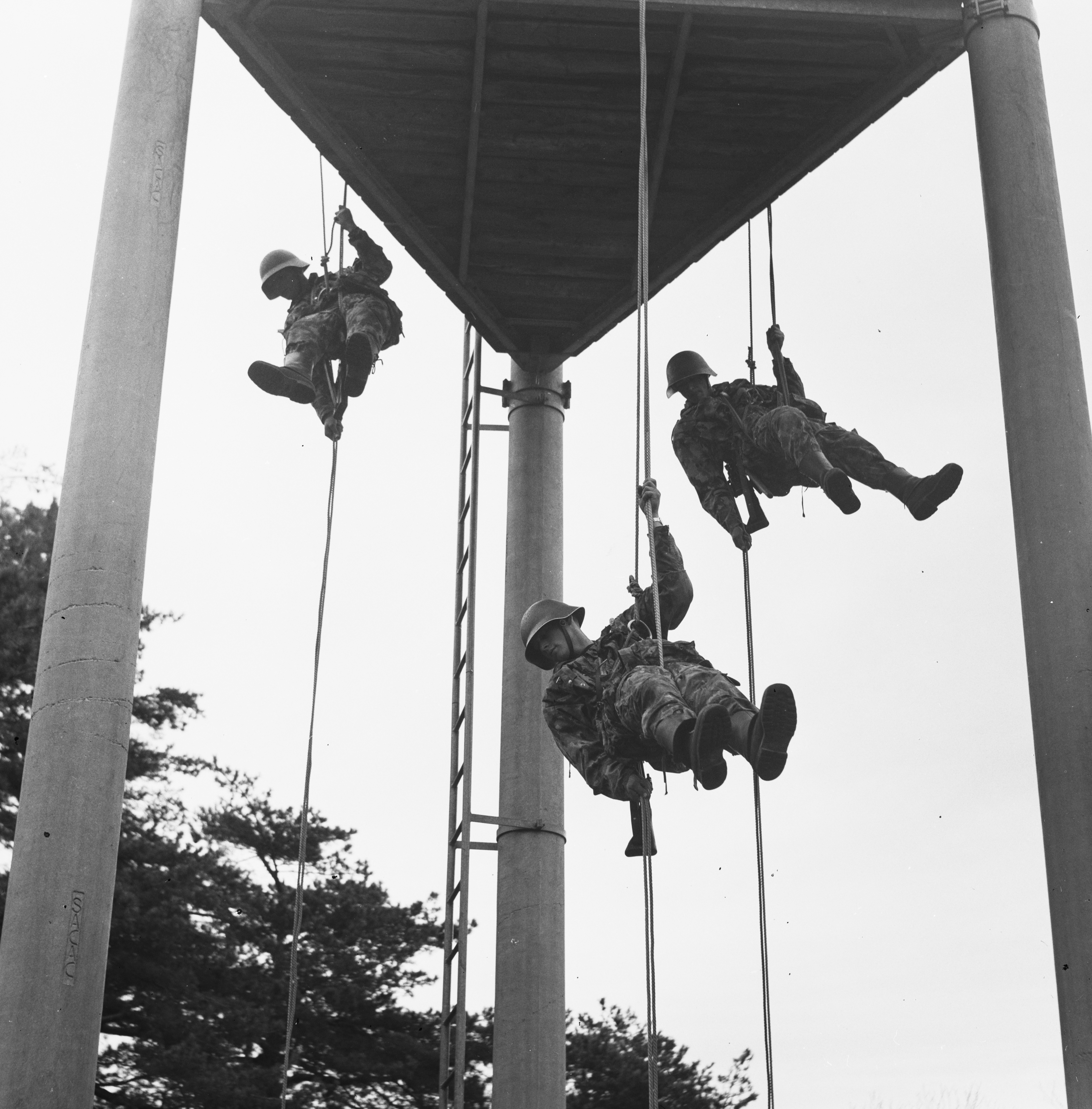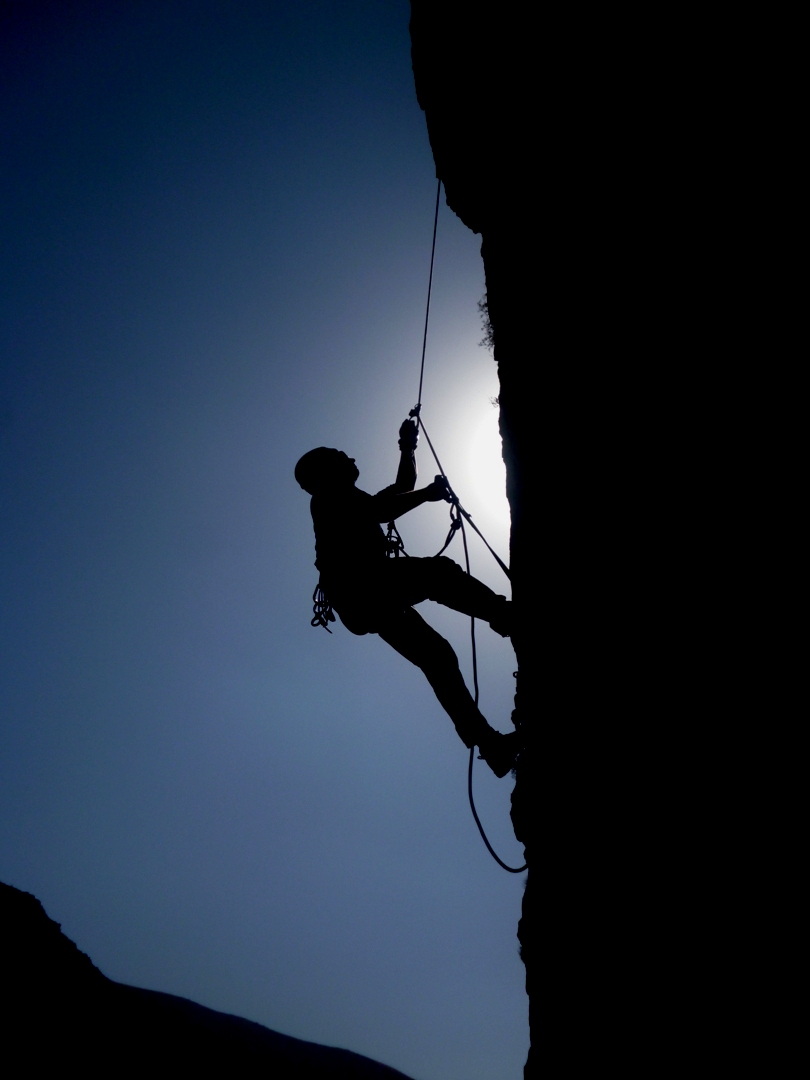|
Dülfersitz
The Dülfersitz (named after its inventor, mountaineer Hans Dülfer), also known as body rappel is a classical, or non-mechanical abseiling technique, used in rock climbing and mountaineering. It is not used frequently any more, since the introduction of belay devices. In the Dülfersitz, the rope is wound around the body, and the speed of descent is controlled using the friction of the rope against the body. The advantages of the Dülfersitz are that one can descend without a climbing harness or belay device, and because the rope is not kinked or subjected to concentrated forces, it does not experience as much wear. The major disadvantage of this method is that intense heat is generated by the friction on the shoulder, neck and thigh, which can be painful, and can damage clothing. Abseiling by means of the Dülfersitz *The doubled rope is passed between the legs *The rope is passed behind one thigh *Crossing the chest, the rope is taken to the opposite shoulder *From the sho ... [...More Info...] [...Related Items...] OR: [Wikipedia] [Google] [Baidu] |
Abseiling
Abseiling ( ; ), also known as rappelling ( ; ), is the controlled descent of a steep slope, such as a rock face, by moving down a rope. When abseiling the person descending controls their own movement down the rope, in contrast to lowering off in which the rope attached to the person descending is paid out by their belayer. This technique is used by climbers, mountaineers, cavers, canyoners, search and rescue and rope access technicians to descend cliffs or slopes when they are too steep and/or dangerous to descend without protection. Many climbers use this technique to protect established anchors from damage. Rope access technicians also use this as a method to access difficult-to-reach areas from above for various industrial applications like maintenance, construction, inspection and welding. To descend safely, abseilers use a variety of techniques to increase the friction on the rope to the point where it can be controlled comfortably. These techniques range f ... [...More Info...] [...Related Items...] OR: [Wikipedia] [Google] [Baidu] |
Hans Dülfer
Hans (Johannes Emil) Dülfer was a German mountain climber (23 May 1892 in Barmen / Wuppertal – 15 June 1915 in Arras). Dülfer started studying medicine from 1911 in Munich, and then changed to law and later to philosophy. The proximity of the Alps enticed him to make 50 first ascents, particularly the Kaisergebirge (in the Northern Limestone Alps) and in the Rosengarten in the Dolomites. * 1911 Dülfer-Kamin am Totenkirchl (literal English: Duelfer chimney at the dead church) * 1912 Fleischbank-Ostwand (literal English: meat-bank east wall) * 1913 Dülfer-Riss der Fleischbank (literal English: Duelfer crack of the meat bank) Dülfer developed several early climbing techniques, such as the Dülfersitz rappel, a basic emergency abseil skill. He died in World War I World War I (28 July 1914 11 November 1918), often abbreviated as WWI, was one of the deadliest global conflicts in history. Belligerents included much of Europe, the Russian Empire, the United State ... [...More Info...] [...Related Items...] OR: [Wikipedia] [Google] [Baidu] |
Com M12-0346-0015-0001
Com or COM may refer to: Computing * COM (hardware interface), a serial port interface on IBM PC-compatible computers * COM file, or .com file, short for "command", a file extension for an executable file in MS-DOS * .com, an Internet top-level domain, originally short for "commercial" * Component Object Model, a Microsoft software interface technology * Computer-on-module, a type of single-board computer Transport * Comair (USA), an airline which was a wholly owned subsidiary of Delta Air Lines by ICAO airline designator * Commonwealth MRT station, a Mass Rapid Transit station in Singapore by MRT station abbreviation Other * ''COM'' (manga magazine) * Cốm, green rice dish in Vietnam * Common rail (electricity), a common path of currents in an electronic circuit, often for the ground * Center of mass * Center-of-momentum frame * Coma Berenices (constellation), standard astronomical abbreviation * Comoros, ISO 3166-1 alpha-3 country code * College of the Mainland, a communi ... [...More Info...] [...Related Items...] OR: [Wikipedia] [Google] [Baidu] |
Mountaineering
Mountaineering or alpinism, is a set of outdoor activities that involves ascending tall mountains. Mountaineering-related activities include traditional outdoor climbing, skiing, and traversing via ferratas. Indoor climbing, sport climbing, and bouldering are also considered variants of mountaineering by some. Unlike most sports, mountaineering lacks widely applied formal rules, regulations, and governance; mountaineers adhere to a large variety of techniques and philosophies when climbing mountains. Numerous local alpine clubs support mountaineers by hosting resources and social activities. A federation of alpine clubs, the International Climbing and Mountaineering Federation (UIAA), is the International Olympic Committee-recognized world organization for mountaineering and climbing. The consequences of mountaineering on the natural environment can be seen in terms of individual components of the environment (land relief, soil, vegetation, fauna, and landscape) and locat ... [...More Info...] [...Related Items...] OR: [Wikipedia] [Google] [Baidu] |
Rock Climbing
Rock climbing is a sport in which participants climb up, across, or down natural rock formations. The goal is to reach the summit of a formation or the endpoint of a usually pre-defined route without falling. Rock climbing is a physically and mentally demanding sport, one that often tests a climber's strength, endurance, agility and balance along with mental control. Knowledge of proper climbing techniques and the use of specialized climbing equipment is crucial for the safe completion of routes. Because of the wide range and variety of rock formations around the world, rock climbing has been separated into several different styles and sub-disciplines, such as scrambling, bouldering, sport climbing, and trad (traditional) climbing another activity involving the scaling of hills and similar formations, differentiated by the rock climber's sustained use of hands to support their body weight as well as to provide balance. Rock climbing competitions have the objectives of e ... [...More Info...] [...Related Items...] OR: [Wikipedia] [Google] [Baidu] |





